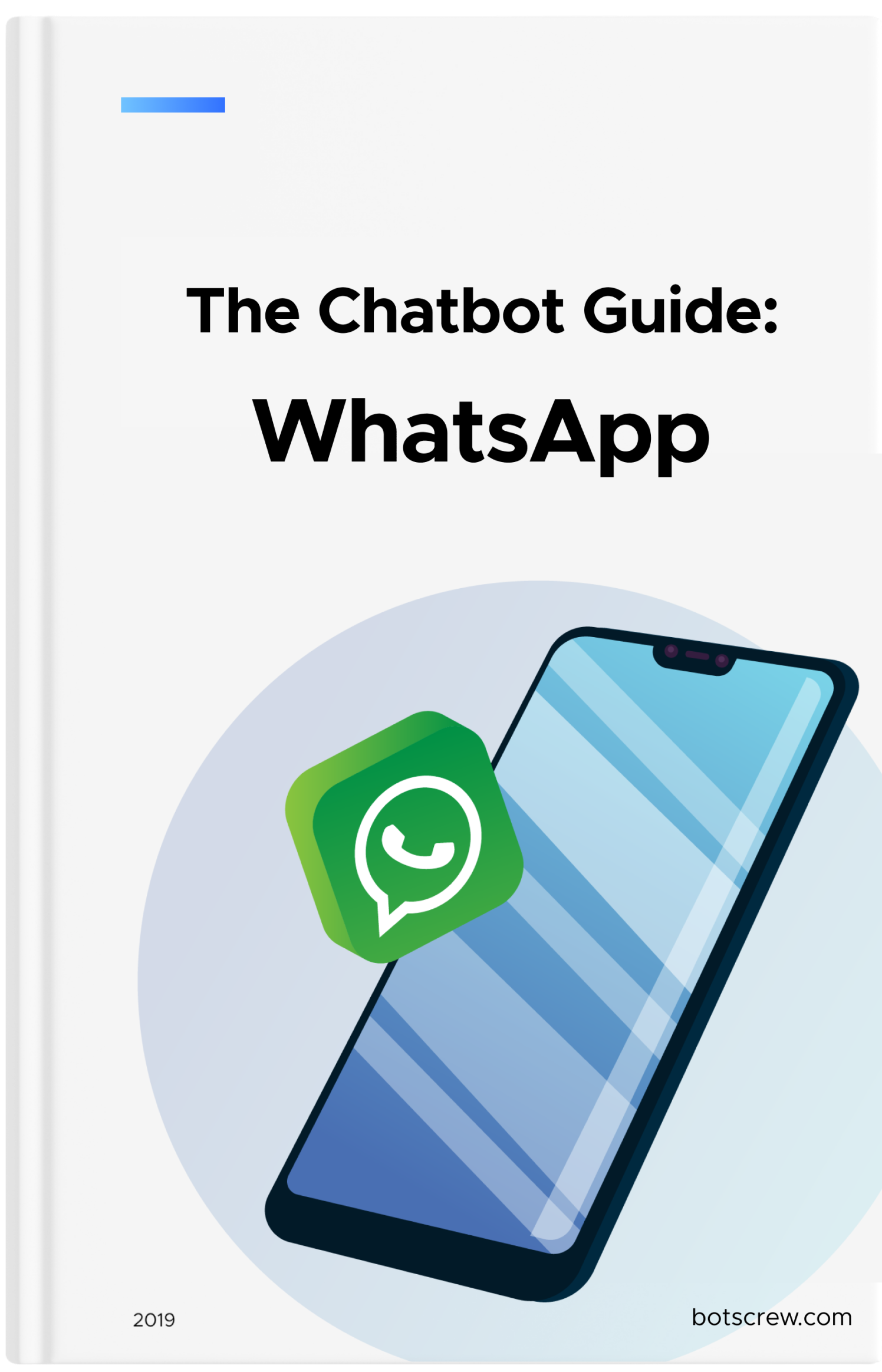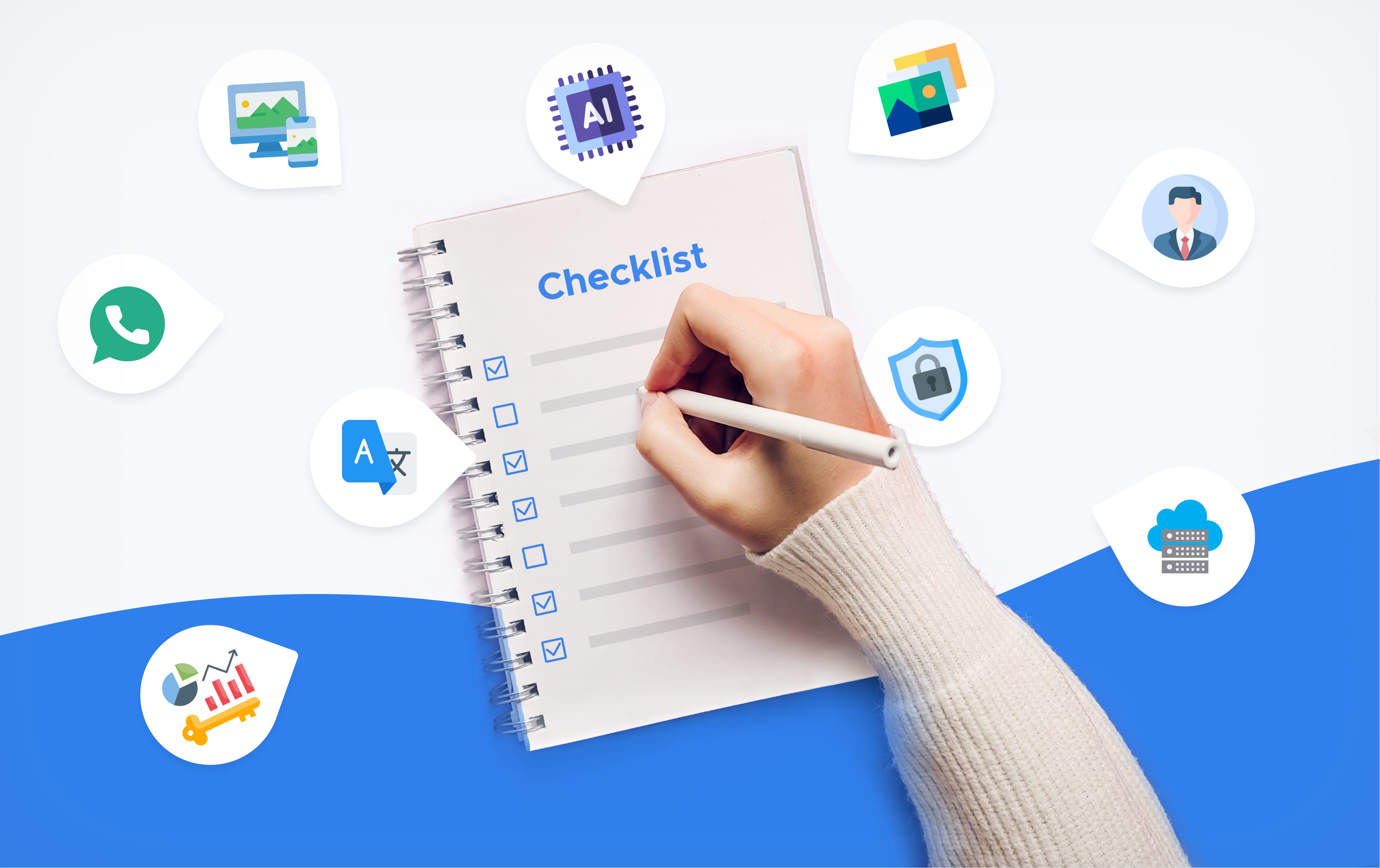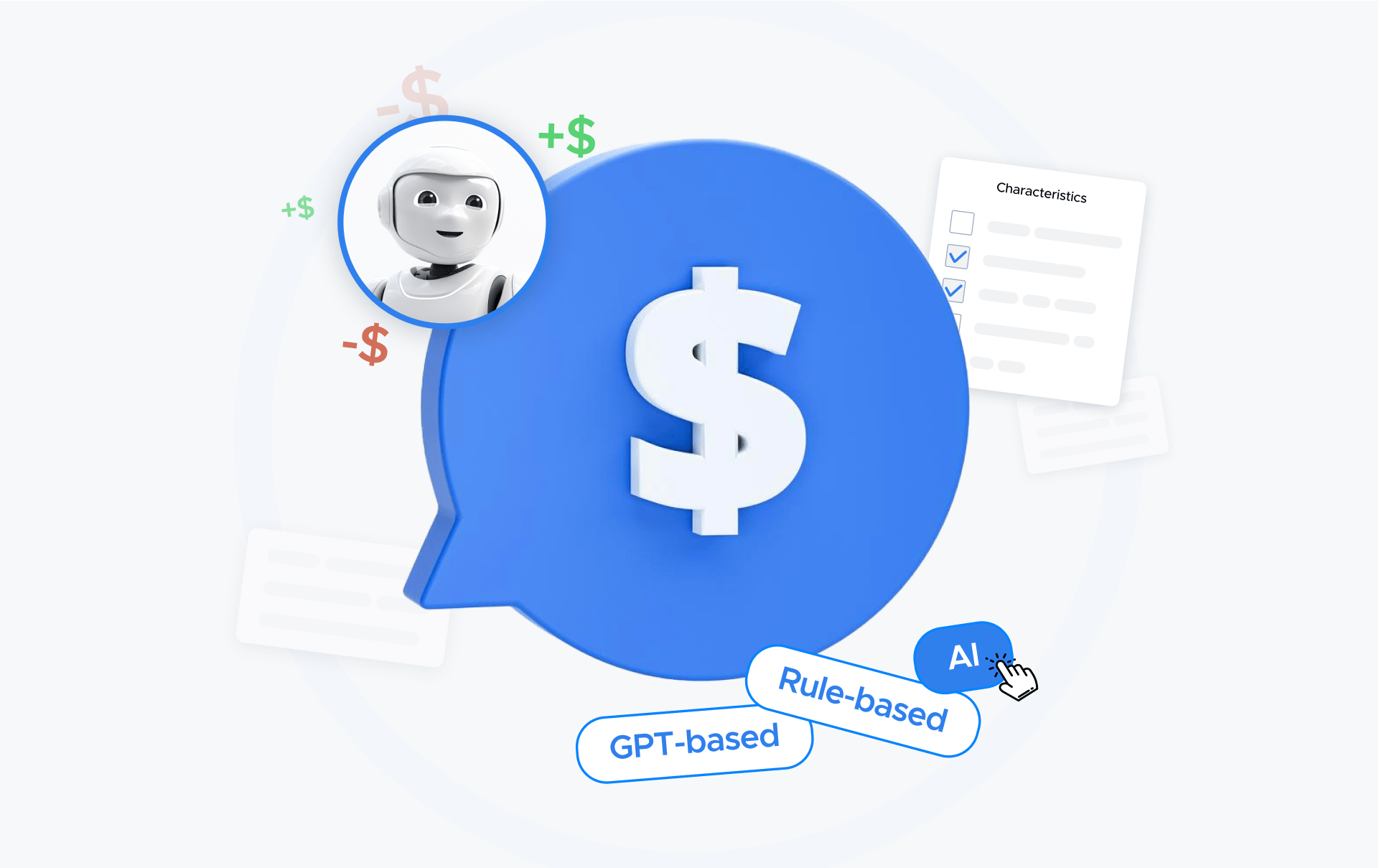Chatbot Development: The Complete Guide for Business in 2025
Chatbot development is a complex process. But if planned correctly, it can become a piece of cake. When starting chatbot development, the main thing is to break this process into clear steps and go by them one by one. So, here we tried to make your life easier and created step-by-step instructions for chatbot development.
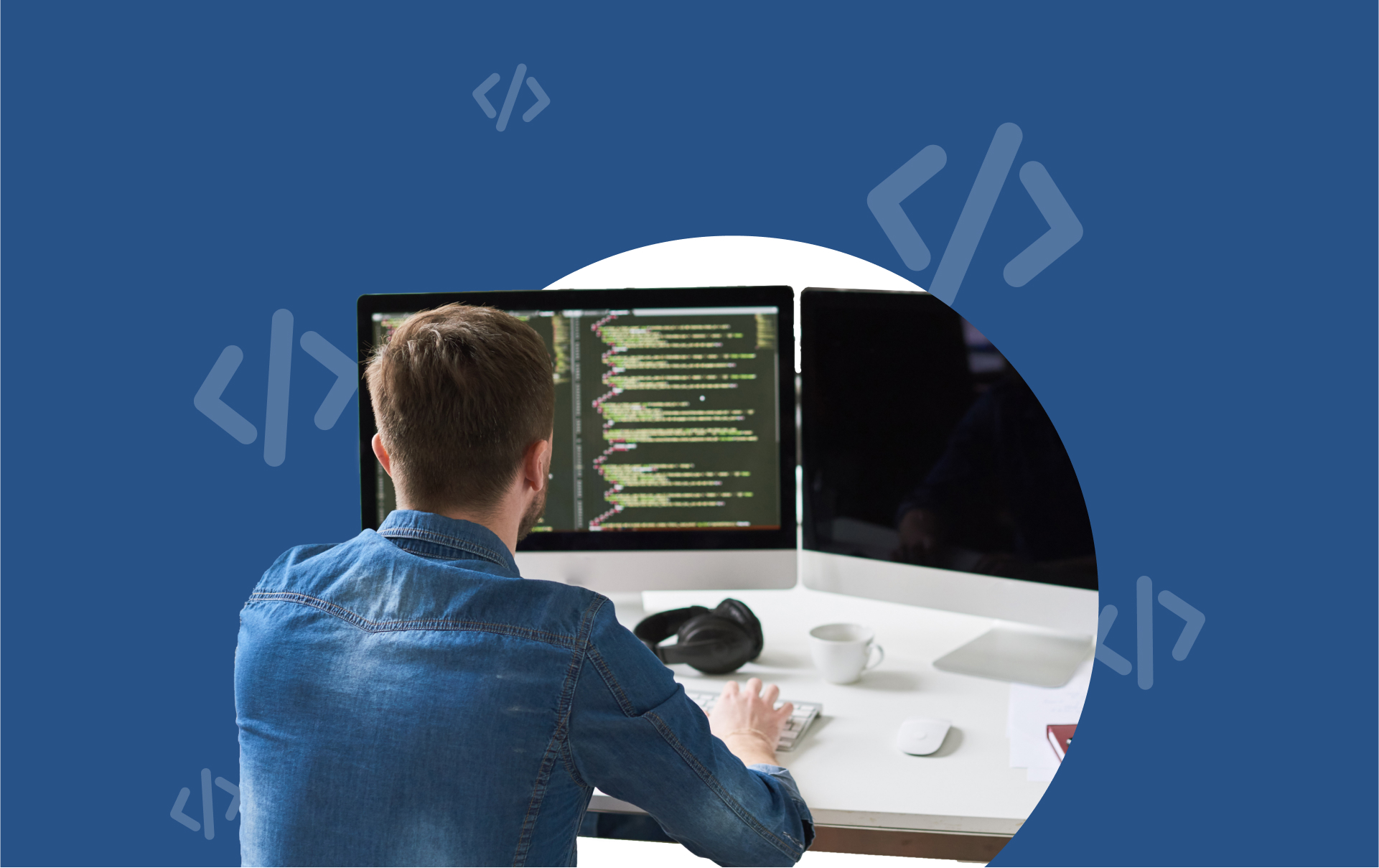
Chatbot development is a process that includes designing, deploying, and supporting a chatbot. The development process may consist of a different number of stages based on how complex the goals of the chatbot are.
Chatbot or bot – a computer program that simulates a natural human conversation. Users communicate with a chatbot via the chat interface or voice, like how they would talk to a real person.
There are many different chatbot features. These features can vary from chatbot to chatbot based on how complex they are and what use cases they cover. The most common chatbot features are:
Natural Language Processing (NLP): Chatbots use NLP to understand and respond to user input, such as speech or text.
Intent Recognition: Chatbots can identify the user’s intent, such as asking a question or making a request.
Dialogue Management: Chatbots can manage and control the flow of a conversation, including handling multiple user inputs and providing relevant responses.
Knowledge Base: Chatbots can access and use a set of predefined information to provide answers to user inquiries.
Integration with external systems: Chatbots can connect to other systems and platforms to access additional information or perform actions.
Personalization: Chatbots can personalize responses and interactions based on user preferences or behavior.
Text-to-Speech and Speech-to-Text: Chatbots can use TTS and STT to interact with users through speech or voice commands.
Multi-Language support: Chatbots can communicate with users in multiple languages
Machine Learning: Chatbots can improve over time by learning from user interactions and feedback.
Analytics and reporting: Chatbots can track and analyze user interactions to provide insights into how the chatbot is being used.
Chatbot Use Cases
Chatbots are widely popular in many industries. There are hundreds of chatbot use cases, and it would be almost impossible to name them all. But here, we included the most popular chatbot use cases that we often stumble upon with our clients.
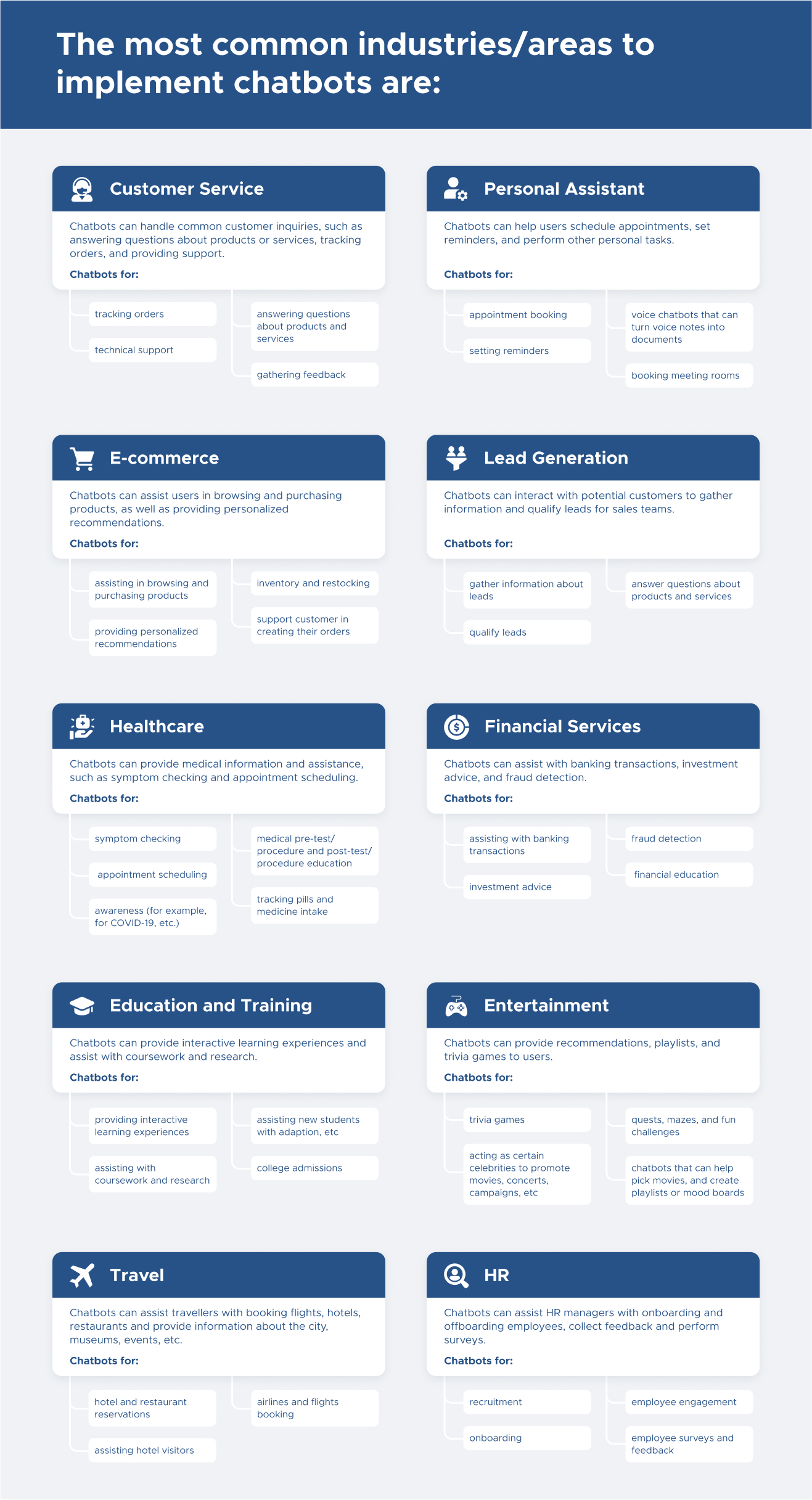
Related content: 21 Chatbot Use Cases For 5 Different Industries
Here are a few real-life examples of different chatbots that we have created:
Below, we covered detailed instructions on getting started with chatbot development from scratch – whether it's a simple chatbot or a complex custom solution.
1. Understand if the chatbot is the right fit for your company
2. Define the chatbot goal or goals
3. Choose the chatbot type
4. Choose channels and languages
5. List the chatbot integrations
6. Choose the right chatbot vendor or chatbot platform
7. Think about chatbot security
8. Create a chatbot persona, design a chatbot flow, and a logic tree
9. Start with building a POC or MVP
10. Start building the full version of the chatbot
11. Add integrations and connect must-have tools
12. It's time to scale!
1. Understand if the chatbot is the right fit for your company

Here we emphasize that the main fit for a chatbot implementation is - having a real business problem/opportunity or idea suitable for automation. Having a chatbot because it's "trendy and cool," "others have chatbots," or "we heard they are popular" are wrong reasons to start chatbot development because it will probably end in disaster and be a massive waste of time and money.
It's the same as buying a car you don't need or know much about because your neighbor has the same one. It doesn't make much sense.
The other good way to validate if the chatbot development is the right fit for you is to calculate the potential ROI of the chatbot. Here's an article to help you with that: Customer Service Automation: The Complete Guide for 2023
Or use the ROI chatbot calculator.
Knowing the ROI, you can make a better decision about whether the chatbot implementation is worth investing in for you or if you should use human agents.
2. Defining the chatbot goal or goals
So, now that you know whether you need a chatbot or not, let’s move further into chatbot development planning.
You need to understand the reason for implementing a chatbot. Stop for a second and ask yourself two questions:
“Which problem would the chatbot solve?”
“What will exactly a chatbot be doing?”
The best way to create a chatbot’s goal is to use SMART goals. A goal can be: “The chatbot should automate 30% of customer service requests about products and our policies in the first 3 months after implementation”.
Also, think about metrics to measure success at the end.
Choose measurable metrics with precise numbers that can be analyzed. For example: “By implementing the chatbot, we want to reduce average ticket resolution time from 4 minutes to 1 minute 10 seconds by July 2023".
To get a more in-depth understanding of how to set chatbot metrics, read our latest article on chatbot analytics and metrics.
Chatbot Analytics: 14 Chatbot Metrics To Track in 2023
Defining areas that the chatbot can take over in customer service
You need to analyze and list current time-consuming and routine processes.
Usually, the best areas for chatbot implementation are client-facing processes that are repetitive.
We’ll start by defining the main customer intents when contacting your customer service.
To do so, we create categories with the most popular customer requests on the same topic.
Let's say you've collected data about popular customer requests and noticed that most of the interactions are about a delivery date. You can group in one category “Delivery info” requests like:
“When will my parcel be delivered?”,
“What is the delivery date?”,
“When I will receive my order,” etc.
Define a few main categories, and let’s move to the next part of this step.
Take a look at the list you created, then evaluate each customer intent/category.
You can assess processes based on:
- Ease – how easy do you think it will be to automate these customer requests?
- Importance– how important for you to automate these customer requests?
- Time – how much time do you think this will take to automate?
- Impact – what impact will it have on your business/customer service if you automate this category with customer requests?
But you can choose other metrics that are important to you.
3. Choosing the right chatbot type
There are a few chatbot types you have to consider:
Button-based chatbots and Rule-based chatbots - These chatbots are programmed to respond to specific keywords or phrases. They are typically used for simple tasks such as providing information or answering frequently asked questions. Usually, to communicate with this type of chatbot, users use buttons or quick replies. These chatbots don’t understand natural language and can’t complete complex tasks, but they are perfect for simple and straightforward actions.
Self-learning chatbots - These chatbots use machine learning algorithms to improve their responses over time based on the interactions they have with users.
AI-powered chatbots - These chatbots are powered by artificial intelligence (AI) and natural language processing (NLP) technologies, such as GPT-3.5, to understand and respond to complex user queries. They are very “smart” and can complete complex tasks and handle natural language pretty well. However, sometimes if developed not correctly, they can be more unpredictable than button-based chatbots.
Hybrid chatbots - These chatbots combine the capabilities of rule-based and self-learning chatbots and can adapt to the needs of the user.
Voice chatbots - These chatbots are designed to understand and respond to voice commands and questions and can be integrated into virtual assistants (like Siri or Cortana) and smart speakers. Also, you can use these chatbots as an IVR system that can be implemented into the customer service department to deflect the number of customer service calls.
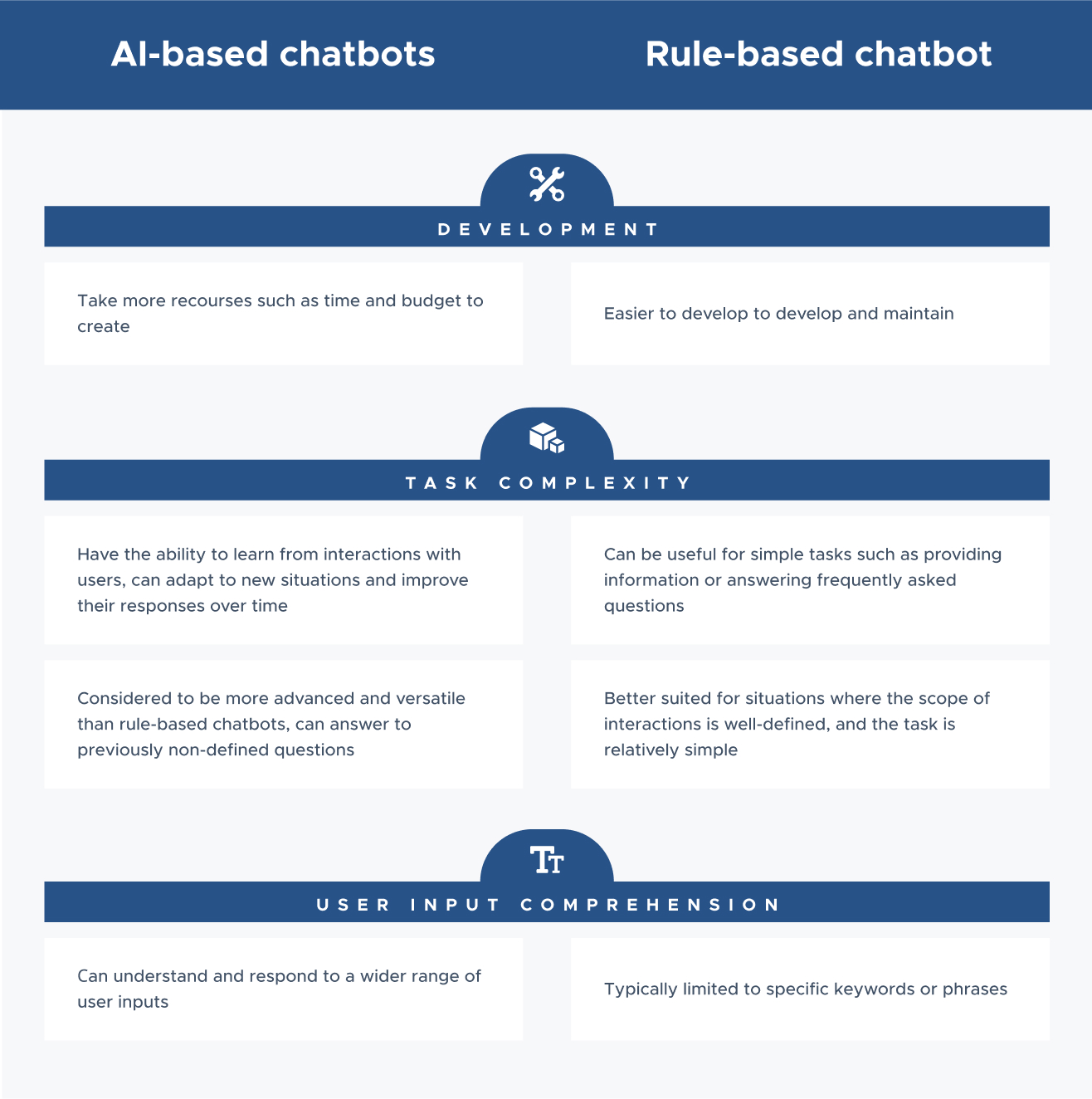
Rule-based chatbots are generally better suited for situations where the scope of interactions is well-defined, and the task is relatively simple.
It’s worth noting that, depending on the use case, a hybrid chatbot that combines the capabilities of rule-based and AI-based chatbots might be more suitable. It all depends on the complexity of the task and the level of user engagement you expect.
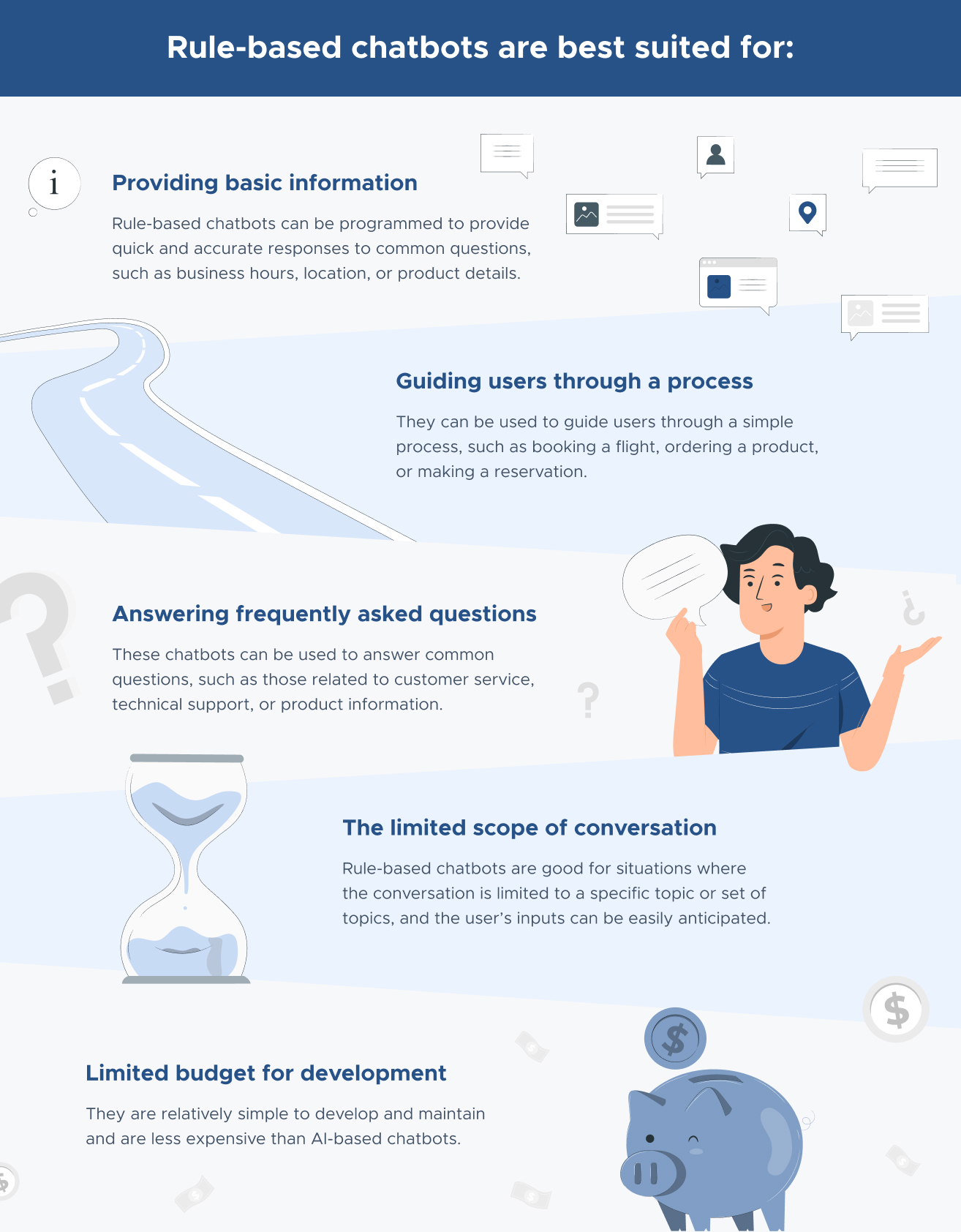
4. Choosing channels and languages
At this step, there are a few more questions you want to ask yourself:
- Which communication channels do you want to automate? Website, WhatsApp, Facebook, or all of them?
- Which languages do you want to automate with the chatbot?
Chatbot channels
Before answering these questions, you have to consider a few things:
- Is it reasonable to develop a chatbot for the volume of customers coming from this channel and speaking this language?
- Is the volume of customers from this channel / speaking this language growing or decreasing?
- Will you support this channel in a long-term plan?
It's also good to evaluate each of these channels the same way you evaluated areas for automation.
Use metrics like:
- Ease of automation,
- Strategic importance,
- Requests volume,
- Impact of this process automation
Multilingual chatbots
To create a multilingual chatbot, start with creating a list of languages you want the chatbot to “speak.” As with chatbot channels, you have to consider whether it is reasonable to develop a multilingual chatbot, and if it is, how many languages do you want it to cover?
From our experience, we recommend companies start with one language and then scale with time.
5. List the integrations
Spend some time to consider and write down possible integrations for your chatbot.
This could be something like:
- CRM ( e.g., Hubspot, Zoho, Salesforce, etc.),
- Calendar (Google Calendar, etc.)
- Payment systems (e.g., Stripe, PayPal, etc.),
- Maps (Google Maps, Apple Maps, etc.)
- Cloud storage tools (e.g., Dropbox, Google Drive, OneDrive, etc.),
- any other business software that your company is using.
And again, you can evaluate each of these integrations the same way you evaluated areas for automation, languages, and channels. Use metrics like “Importance” and “Impact” of integrating these tools with the chatbot. “Ease” and “Time” metrics might be out of your expertise, so you can skip them or leave them for the chatbot development company to fill out in the future.
6. Choosing the right chatbot development company or chatbot platform
You can use a chatbot builder or hire a chatbot development team to consult and create a prototype. Both options are useful, and which one to choose depends on the type of chatbot you want, your business needs, money, and time.
A chatbot company generally offers a more comprehensive solution and can provide additional services such as consultation, design, development, deployment, and maintenance. They may also offer more specialized expertise in specific industries or use cases.
Chatbot development companies offer a range of services that can be more comprehensive and tailored to your specific needs than a chatbot platform alone.
Here are some reasons why a chatbot development company may be a better choice than a chatbot platform:
Customization: Chatbot development companies can provide customized chatbot solutions that are tailored to the specific needs of your business. This can include customizing the user interface, integrating existing systems, and developing specialized functionality.
Expertise: Chatbot development companies typically have teams of experts with a wide range of skills, including software development, design, and user experience. This can help ensure that your chatbot is developed to the highest standards and meets your business requirements.
Technical Support and Maintenance: Chatbot development companies provide technical support and maintenance after deployment. This can help ensure that your chatbot runs smoothly and that any issues are resolved quickly.
Scalability: Chatbot development companies can help you scale your chatbot as your business grows. They can help you anticipate your future needs and develop a solution that can grow along with your business.
Integration: Chatbot development companies can integrate your chatbot into any tools and platforms, including custom software.
On the other hand, a chatbot platform is a software or service that allows you to build, deploy, and manage chatbots without needing to write code using a drag-drop interface. These platforms may be more suitable for businesses with in-house development teams or less complex chatbot needs. Some chatbot-building platforms are a good option if you need a fast and cheap prototype.
In summary, a chatbot company may be a better fit if you are looking for a more customized and full-service solution. A chatbot platform may be a better choice if you want a more self-service option or want to build a chatbot quickly and easily.
Here are two lists that can help you find your perfect company or platform fit:
If you don’t want to screw up with choosing a reliable chatbot development company, consider these things:
Experience and expertise: Look for vendors with a proven track record of developing chatbots for businesses similar to yours. Make sure they have experience and expertise in the technologies and platforms you are interested in.
Customization and scalability: Chatbots should be customized to meet the specific needs of your business, so look for vendors that offer flexible solutions that can be adapted to your requirements. Also, consider if the vendor can scale up or down as your business needs change.
Technical support and maintenance: Find out what kind of technical support and maintenance the vendor offers after the chatbot is deployed. Ensure they have the resources to help you troubleshoot and maintain your chatbot.
Pricing and contract terms: Compare pricing and contract terms among different vendors to find the best value for your budget. Look for vendors that offer transparent and flexible pricing and contract terms.
Communication and collaboration: Good communication and collaboration with the vendor are essential for a successful project. Look for vendors that are responsive and easy to work with.
Security & Compliance: It’s essential to work with a vendor with experience and knowledge in providing secure and compliant chatbot solutions. Make sure to understand their security and compliance measures.
Considering these factors, you can find a vendor to provide you with the best possible chatbot solution for your business.
If you think you have found your perfect fit chatbot vendor at this stage, you need to:
- Discuss and set clear Key Performance Indicators (KPI’s),
- Set milestones and deliverables,
- Discuss time and budget estimates for the chatbot development,
- Discuss your involvement in the whole chatbot development process,
- And also, discuss your future communications with your chatbot vendor: How often will you have calls? Demos? What communication channels will you use? Etc.
If you need help creating chatbot requirements, check out our recent article on crafting proper chatbot requirements.
Chatbot Requirements: Technical & Non-technical Things to Consider
7. Think about chatbot security
Consider high-security standards and data encryption for the chatbot. Also, you need to consider Privacy Policy, GDPR, HIPAA, or other compliances.
Talk to the chatbot vendor about chatbot security, as it's crucial for users and your business. You can read more about GDPR in chatbots here: How To Make Your Chatbot GDPR Compliant
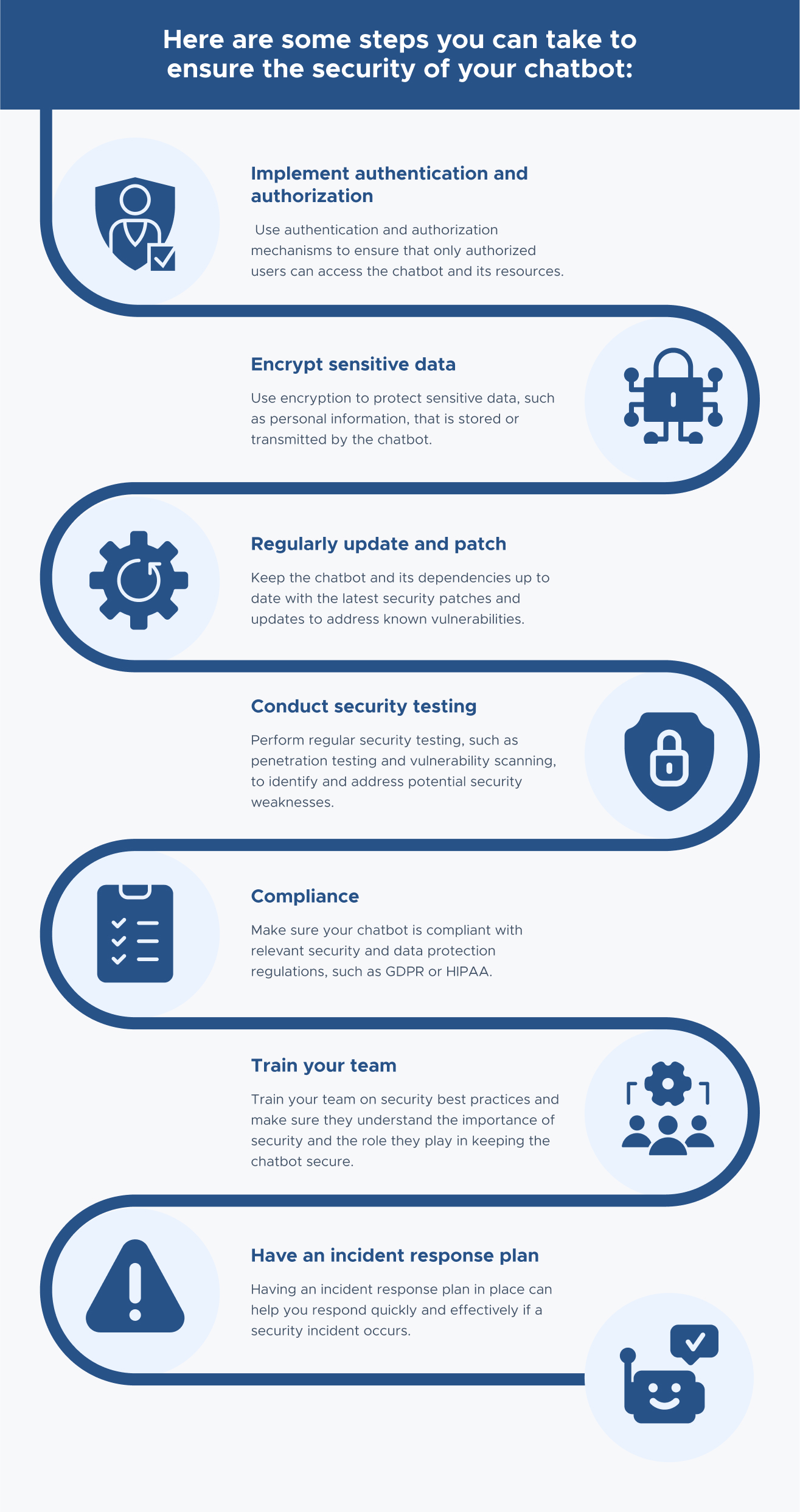
Following these best practices can help ensure that your chatbot is secure and protected against potential threats. It’s important to remember that security is an ongoing process, and you should continuously monitor and update your security measures to adapt to new threats and vulnerabilities.
8. Creating a chatbot persona, designing a chatbot flow, and a logic tree.
You need to know your chatbot's audience to build a relevant bot's flow, tone of voice, and vocabulary.
Usually, if you are working with chatbot development companies, they will help you form your chatbot's flow, persona, and logic tree. You only need to collect and answer the most common questions you want the chatbot to cover.
Talk to your customer service agents and sales team – ask what questions they get the most often,
- Review call logs and scripts, email chains,
- Analyze FAQ pages, knowledge base,
- Check your @support or @info Inbox for repetitive requests,
- Check your Social Media to find customer questions.
- Think about what are the most repeating questions and issues your clients stumble upon.
If you are working with the chatbot development team, collect these question-answers pairs, and provide them to the vendor. These Q&A pairs will be a base for the chatbot flow.
However, if you are creating the chatbot using a platform, you must consider which questions, words, and phrases your chatbot must understand. And it’s better to be specific and collect as many ways of saying the same thing as possible to train the bot.
For example, the customer can ask the bot about your working hours in many ways: “What are your working hours?”, “When does your shop close?”, “When does your shop on 5th Avenue start working?” etc.
Write down as many variations of words and phrases of specific customer requests as possible to train your bot. The more variations you train your bot with, the smarter it will get and the fewer mistakes it will make with real users.
When you have settled with the main part of the flow – Q&As, there are other conversational elements you need to consider:
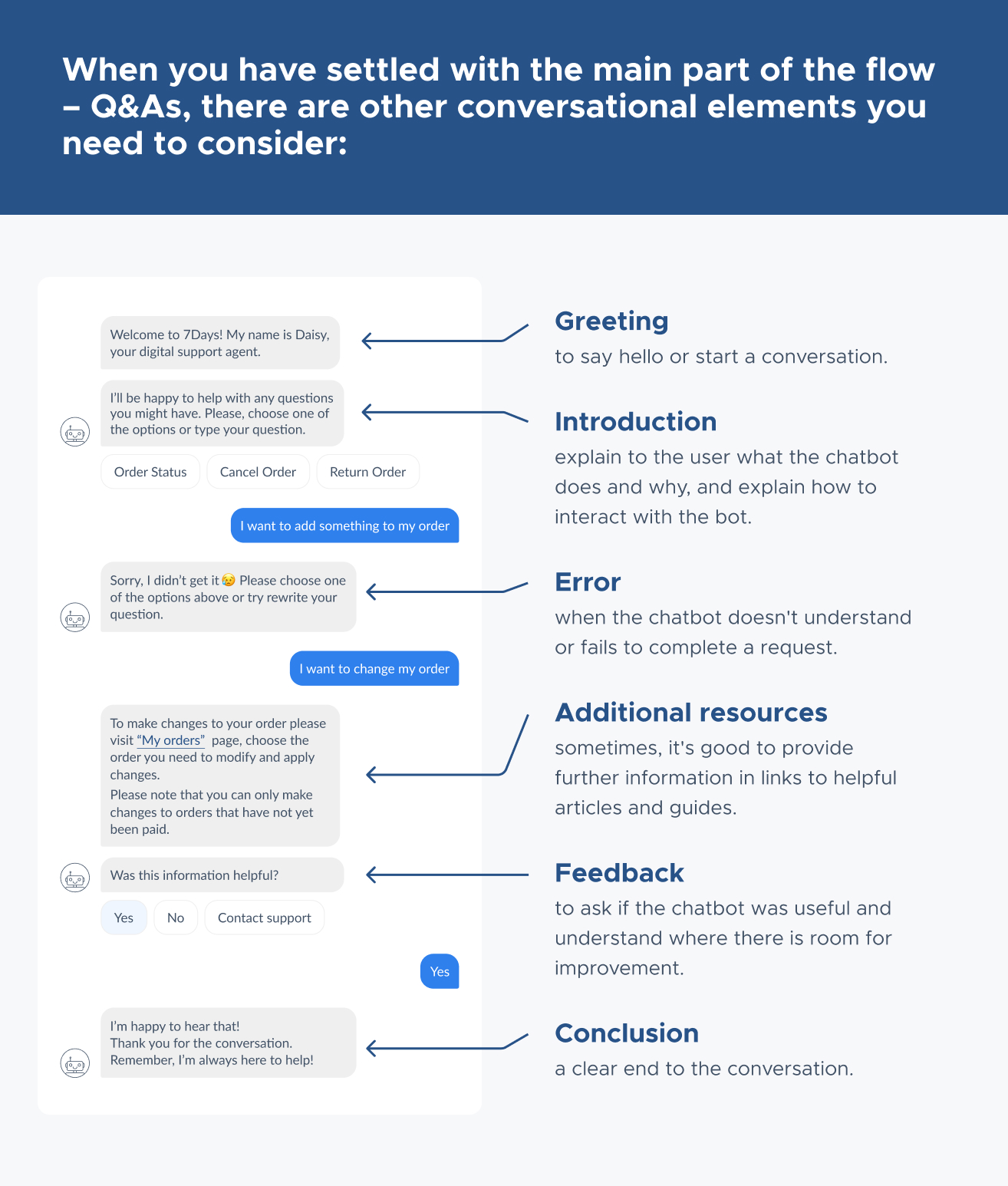
9. Start with building a POC or MVP
Start small – then scale.
The best way to create a successful project is to create a POC (Proof of Concept). Set goals and expectations for the POC, build it, and then do user testing with small focus groups or actual users.
You can scale if you achieve the set goals and expectations with your POC. If you don't reach the desired outcomes, you must sit down and analyze what went wrong, where, and why. You need to think about how to improve and optimize your POC.
The best way to test a chatbot is to have a conversation with it and pay attention to things like:
- Bots flow – is the chatbot’s dialog logical, correct, and smooth? Does the flow make sense from a user's side? Is it understandable and comprehensible for the users?
- Conversational User Experience (CUX) – is the chatbot flow well structured? Is it engaging to talk to a bot? Does it use emojis, buttons, gifs, and images, and understandable for user wordings? Is the chatbot persona appealing?
- Speed – how fast does the chatbot respond?
- Accuracy – are all the chatbot answers correct and accurate?
- Fallbacks – what will a bot do when he doesn’t understand the user? What will the chatbot answer? Or where will a bot redirect?
There are a few options on how to find users for chatbot testing.
One way is to ask your co-workers to join the chatbot testing and analyze their interactions with the chatbot. Remember that your staff can be biased as they are familiar with specific terminology, your company, services, etc., and how they interact with a bot can differ from your chatbot's audience.
Also, you can involve your real customers in the beta testing of the bot. You can ask your most loyal clients to join the testing. Or, as an example, you can engage your current clients to chat with the bot for a reward like a discount or a coupon if applicable.
Another option is to use crowd-testing. Some sites help connect with real testers. For example, you can go on Reddit and find beta testers in subreddits like TestMyApp. Or use a website like BetaFamily. You can also set up chatbot testing sessions on UserInterviews, where you can choose the audience more precisely.
And remember, the more people interact with your bot, the more training data you will get to prepare your chatbot for different use cases.
10. Start building the full version of the chatbot
It’s always good to learn from your mistakes.
After your POC has been tested, analyze and iterate to make your solution deliver the best results.
Pay attention to:
- Fallback rate – check how often and where the chatbot didn't understand the question and provided a “Sorry, I didn't get it" type of answer.
- Check the session durations and calculate the avg. session duration. If the session duration is very short, it often means that the chatbot isn't engaging or helpful. However, if you have a concise flow or minimal functionality, this isn't the best metric to consider.
- Analyze drop-offs – how many users dropped off? Where they dropped off, and why?
- Goal Completion Rate – how many successful engagements have users had with your chatbot? For example, if your bot use case is scheduling a meeting or buying a product, how many users did that?
- User satisfaction – if you have a feedback feature in your chatbot, check how users rated your bot.
Understand what needs to be improved, changed, or added, and do it. Or ask your vendor to do it.
Chatbot Requirements: Technical & Non-technical Things to Consider
11. Adding integrations and connecting must-have tools
Some tools have native integrations. It means you can connect specific tools in a few clicks without coding. Commonly, small tools connect with giants like Salesforce, Zendesk, etc. But it’s not always the case that the giants connect with one another. For these cases, you’ll need a custom integration or a 3rd-party integration tool.
The systems you want to connect need an open API (application programming interface). It is valid for 90+% of the cases. However, you should think about how you’ll use it because there is no need to integrate every tool. Choose a hub where you want to have all the data, and then incorporate your tech stack with this hub.
There are 3rd-party integration tools like PieSync and Zapier. But with a large volume of data points, it is always more cost-effective to build an in-house integration (if native integration is unavailable).
12. It’s time to scale!
Technology and chatbots, especially, are not a set-and-forget thing. You should continuously review, analyze, and improve your chatbot.
Technology and chatbots, especially, are not a set-and-forget thing. You should continuously review, analyze, and improve your chatbot.
So, expand your chatbot capabilities, and add new channels, languages, and integrations. Keep improving your solution and make it even better.
Usually, together with our clients, we have plans and goals set for future upgrades and new versions of the chatbot. While it’s okay to scale your product when you need this, it is always a good idea to picture your solution in 12-24 months.
Summing Up
Okay, so we went through the chatbot development process, and as you may notice, the critical component here is to create a good plan and find reliable vendors. Try going by these steps one-by-one and not do everything at the same time.
Good luck with your first chatbot project!
How long does it take to create a chatbot?
The time it takes to develop a chatbot can vary widely depending on several factors such as the complexity of the project, the size of the team, the type of chatbot, the platform you are using, and the integration requirements. A simple chatbot with pre-defined responses and basic functionality could be developed in a matter of weeks. However, a more complex chatbot with natural language processing, machine learning capabilities, and integration with external systems could take several months to develop.
How much can a chatbot development cost?
Chatbot pricing varies on your needs and goals. For a simpler bot without NLP and many additional integrations and languages, you can expect to pay from $10,000 to 75,000. For a more advanced solution, it can be from $50,000-150,000 or even more if you need a lot of integrations, languages, NLP, and training for your team.




